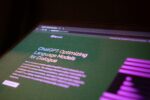There are two things that have arisen from the COVID-19 pandemic which I have found particularly informative. The first is the extent to which we actually require some degree of ‘normality’ – whatever that normality might be. Routine and familiarity give us a framework, a familiar territory to which we can ‘attach’ adaptations and improvisations when we need to – so that we don’t need to plan every novel sequence of everyday experiences and action from scratch. In our minds, cognitively, we can logically reconcile many of the strange and unusual things we have encountered during this crisis; that the streets were empty, that there was no traffic, and that people have been wearing masks. We also knew that we were working in unfamiliar ways, using video calls in place of familiar routines in familiar contexts, in fact an often-bizarre combination of professional business activities and homely domestic settings; in dining rooms, amongst children’s toys or bedroom furniture.
We will have taken all that ‘on board’ at a conscious level, but only at a cost. At a deeper subconscious, instinctive level, these strange and unfamiliar situational discrepancies will eroded our wellbeing. Whatever our risk dispositions, we will have been more disoriented than expected by such dramatic changes to the backdrop, and the context, of our day-to-day lives. The disappearance of supportive, taken for granted, familiar frameworks inevitably take its toll, and this is cumulative. Add in, or take away, the daily commute, the queuing up to shop, the dramatic changes in socialisation opportunities – to the subconscious mind, these erosions of the familiar will have left their mark. They will have been experienced as curious, as troublesome or, to some, as catastrophic. All required some degree of emotional adjustment. It’s little wonder that eventually the initial appeal, the excitement and the self-satisfaction of coping successfully with disaster, were losing their appeal. Rethinking the “we’re all in this together” joys of isolation, discovering the downsides of working from home, left many longing for the old normal. All we can say with any certainty, is that people have been in ‘coping mode’. Just how deep or superficial the changes required by COVID-19 have been, only time will tell.
The second interesting and informative point that the pandemic has brought to the forefront of our minds is just how extraordinarily different we are from one another. We see people in our families, in our neighbourhoods, across the country and internationally, reacting in extremely variable and contrasting ways. Everything from those not daring to venture out at all, wearing masks at ALL times and ‘neighbour snooping’, to demonstrations about “too severe” lockdowns and “laissez-faire”, “just let things roll” attitudes. As you walked around the streets you would have seen how differently people were coping. Some were genuinely quite terrified, very fearful and apprehensive, while others were relaxed, casual and even ‘gung-ho’. The most fearful were having a nightmare, others seemingly just conformed with what was expected of them, or out of respect for other people much more troubled than they were. Throughout, we saw a huge variation in the responses of different individuals to what was, objectively, the exact same danger. It is quite obvious that different people perceived and experienced this encounter with risk in extraordinarily different ways.
Disruption creates opportunity. As we emerge, post COVID, and as restrictions are eased, we will generate very varied visions of a ‘new normal’. Creativity, previously repressed by lock-down authoritarianism, will bounce back, full of exciting ideas. Decisions will be made drawing from the ingenious solutions discovered in an irrepressible ’life must go on’ spirit to deal with widely varied personal challenges. Everything will be on the table; from the closure of brick-and-mortar offices in favour of a more hybrid workforce to attempts at precise restoration of traditional working practices. Arguably, the herding enforcements of COVID-19 ran rough-shod over individual dispositions and circumstances. There will be some positive take-aways but it would be tragic if, as industry and commerce are re-booted, we were to repeat that ‘one size fits all’ approach, completing a double-whammy of employee herding – this time on the way back to work. Hopefully, this time we would recognise the vast differences amongst individual hopes and expectations and find new ways to be ‘people centric’ rather than imposing a fashionably radical “new normal”? So how should HR teams approach this?
Initial excitement has eroded. Employees have been dealing with the effects of COVID-19 on their health, family and of course work life for nearly a year now. Some individuals are fearful of the future, some can’t stand the uncertainty of not knowing what is going on. If you have not formulated a return-to-work plan, now is the time to do so. But remember that all industries are different, there’s a degree of commonality within your workplace which is different from another. So, if you’re reading that every Tom, Dick or Harry known to humanity are ditching the lease, it doesn’t mean it’s necessarily right for your business.
Routine and familiarity give us a framework. A year of COVID was a year of adjusting to new familiarities. Resilient lovers of change will have enjoyed that experience and will now be ready to go again. Those that we most rely on to be organised, systematic and reliable will have loathed it and be apprehensive about ‘what’s coming next’. Not the best foundation for further disruptive decision making. Whether people have coped through resilience, rationalisation, managing their cognitive dissonance, dogged determination or wading through the discomfort of their persistent disorientation, fear, or anxiety, they are not now where they once were. Amongst those whose lives were disturbed by COVID-19 arrangements will be some will want to carry on in that new vein, some want to revert, some would take time to reacclimatise; even some who weather everything that life throws at them unperturbed. In general, though, as human beings, familiar routines, surroundings and arrangements feel comfortable, feel safe and secure and are the least drain on our emotional capital. They provide a supportive work context that we take for granted and just ‘get on with’. And, building on that foundation, people may seek social engagement, intellectual stimulation, friendships, growth opportunities, cultural dimensions, personal recognition, responsibility and career advancement and a host of other personal values. A bit like transplanting a favourite tree, first establish the ideal location, then foster the development of roots?
Clearly different people will perceive a different situation as risky. Every individual’s perspective is narrow in its own way. Managing people well is not just about achieving consensus amongst an influential group of senior managers and driving through the inspired vision of the moment; it takes into account the diversity in individual temperaments and values amongst the talent that delivers for the business. To maximise buy-in and to achieve change that ‘sticks’, decision-makers ignore these realities at their peril.
Given the turmoil of the pandemic, the next step is to make serious efforts to gauge the reality of the aftermath at the end of this period of enforced disruption. To allow a period for staff to readjust, to take stock, to reflect, before making further dramatic changes. Encourage managers, supervisors, team leaders to liaise with their own people to gauge their feedback and incorporate findings into corporate decision-making strategies – rather than jumping to conclusions without consulting your staff.
A healthy decision-making team needs to be diverse, especially in its sensitivity to risk. It is a team in which each individual is aware of their personal biases (and we all have them), who understand how varied are the dispositions of their peers, who contribute on a basis of openness and mutual respect. This is the best antidote to ‘herding’ and ‘group think’ and it recognises that, rather than necessarily being antagonistic, differences maximise the scope and power of the decision-making process.
So, be transparent about your organisation’s strategy to get through this post-pandemic period. Involve employees in pursuit of a common plan and objectives. Regular communications, exposure and participation, encouraging employees to ‘get on-board’ with the project will help to review and rebuild organisational culture in a way that utilises the varied experiences of the recent past. The ‘new normal’ is not ‘off the shelf’, it doesn’t come out of a catalogue, it has to be tailor made.







